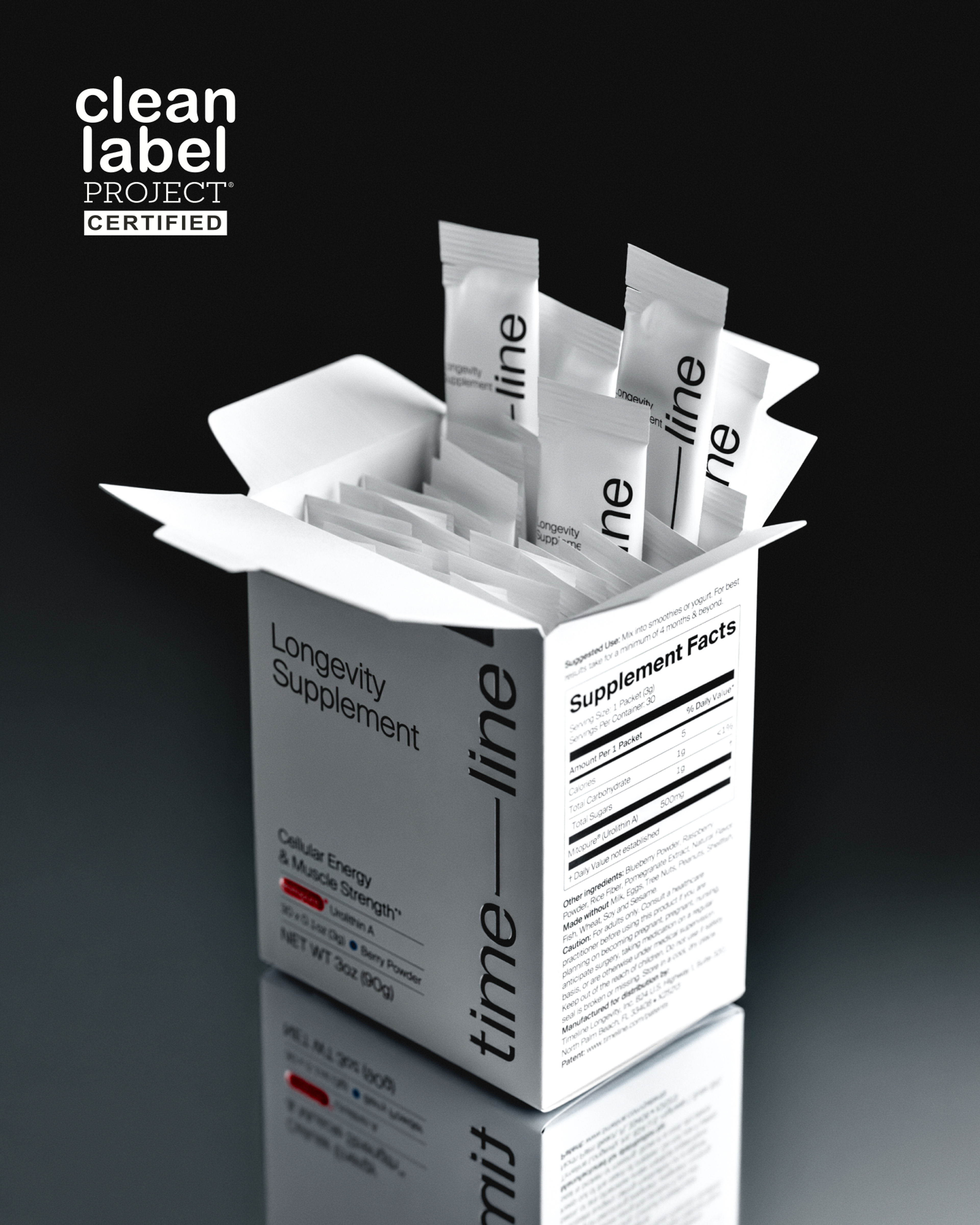Top 5 Superfoods for Urolithin A
Pomegranates, berries, and walnuts are top Urolithin A superfoods, rich in polyphenols needed by your gut to produce this beneficial compound.

What to know
Urolithin A supports muscle health and longevity by stimulating mitophagy, the recycling of old mitochondria into healthier ones.
As a postbiotic, Urolithin A is not naturally occurring in our diet but instead synthesized by our gut bacteria.
Dietary Urolithin A precursors such as ellagitannins and ellagic acid can be found in pomegranates, strawberries, walnuts, raspberries, and almonds.
Not everyone’s gut microbiome can efficiently convert polyphenols into Urolithin A; studies show only 40% of people produce detectable Urolithin A levels from diet alone.
Mitopure® is the first and only Urolithin A supplement that can provide a more reliable and bioactive source of Urolithin A, than diet alone.
Urolithin A is a little-known nutrient that is starting to garner a lot of well-deserved attention. Numerous studies are being released demonstrating its powerful effect on muscle health and longevity.
Cellular mitophagy is a vital process that replaces dysfunctional mitochondria with healthier ones, and Urolithin A plays a key role in stimulating this process. Given that mitochondrial dysfunction is a primary hallmark of aging, Urolithin A is able to foster cellular energy, support muscle function, and promote overall longevity.
What are superfoods?
While there is no formal definition of the word superfood, this term is generally accepted as a description of food that is particularly rich in health-promoting nutrients. They are usually low in calories, high in vitamins and minerals, and contain compounds like polyphenols, antioxidants, or even pre- or probiotics.
Their abundance of nutrients drives people to consume them for enhanced energy, heart health, improved memory, longevity, and prevention of many chronic diseases and conditions.
Is Urolithin A accessible through diet?
Urolithin A is not found directly in the food we eat. It is a postbiotic, meaning that the bacteria in our gut convert plant compounds (called polyphenols) into Urolithin A.
Regularly eating foods high in these specific polyphenols supplies your microbiome with the precursors it needs to generate Urolithin A. Here are the top five superfoods rich in Urolithin A precursors.
Foods rich in Urolithin A precursors
Since Urolithin A is a postbiotic made from our microbiome, you won’t find many foods high in this nutrient. Instead, what you will find are foods rich in ellagitannins and ellagic acid - the polyphenols that can be converted into UA.[1]
The top 5 superfoods for Urolithin A:

1. Pomegranates
The pomegranate Urolithin A connection is well known. The ruby-colored fruit is high Urolithin A precursors. Additionally, pomegranates are one of the best sources of antioxidants. They have even higher levels than red wine and green tea.[2]
Consuming pomegranates regularly has been associated with lower risks of certain types of cancer, heart disease, and even arthritis.[3] This, combined with its nutrient profile, puts the pomegranate at the top of our list.
2. Strawberries
Similar to the pomegranate, strawberries are high in Urolithin A precursors. [4]In addition to being high in polyphenols and antioxidants, strawberries are a great source of vitamin C.
Research shows a strong link between strawberry consumption and lower levels of the inflammatory marker C-reactive protein, demonstrating its potent anti-inflammatory effects.[5]
3. Walnuts
Walnuts top many superfood lists as they are a rich source of anti-inflammatory omega-3 fatty acids.[6] They’re also high in vitamin E, a powerful antioxidant. In addition to these well-known benefits, walnuts are rich in polyphenols, including Urolithin A precursors. And any food that’s high in Urolithin A precursors makes our list of health-promoting superfoods.
4. Raspberries
One cup of raspberries has 8 grams of fiber which makes up 32% of the daily value for fiber. Since less than 7.5% of Americans get the daily recommended amount of fiber,[7] this fact alone makes raspberries a superfood. Their abundance of antioxidants and polyphenols, including Urolithin A precursors, are further proof of their health-promoting benefits.[8]
5. Almonds
From almond milk to almond flour and everything in between, this superfood shows up just about everywhere. And for good reason. Consuming almonds is associated with better heart health, lower blood pressure, weight management, improved cognitive performance, and even promoting microbiome diversity and richness.[9]
In addition to being a great source of fiber, healthy fats, calcium, and iron, they are rich in polyphenols, including the Urolithin A precursors.
Can everyone produce Urolithin A naturally?
The benefits of eating a healthy diet are well established, and research suggests that consuming superfoods such as the ones we’ve identified may have a powerful impact on your health and longevity. In almost every case, food is always preferred over taking a dietary supplement. However, when it comes to Urolithin A, eating foods high in Urolithin A precursors might not be enough.
Ideally, everyone’s gut microbiome would be capable of metabolizing the dietary precursors into Urolithin A. Unfortunately, for most people, that’s not the case.
Research showed that after ingesting pomegranate juice, a rich source of Urolithin A precursors, only 40% of people had converted these polyphenols into detectable levels of Urolithin A. The study also showed that direct supplementation with Mitopure® provided six times the amount of Urolithin A compared to diet.[10]

Mitopure Softgels
4.5 · 3690 reviews
The simplest form of Mitopure
To truly reap the benefits of Urolithin A, it appears that in this case, food alone may not be enough.
Supplementing with active Urolithin A
A recent study published in Nature found that direct supplementation with Urolithin A can overcome gut microbiome variability.[11] That’s why we developed Mitopure®.
Mitopure® is the only clinically tested form of Urolithin A. Proven to enhance cellular energy, Mitopure® also carries exercise-like effects. Supplementation with Mitopure increased muscle strength by up to 12% after 16 weeks and increased muscle endurance by up to 17% after 8 weeks without more exercise!
The verdict
There is no doubt that eating a healthy diet that focuses on a wide variety of nutritious food is the best way to prevent disease. While superfoods can provide much-needed nutrients, it’s essential to balance a mixture of fruits and vegetables with lean protein, healthy fats, and fiber-rich carbohydrates.
This article has been recently updated since its original publication.
Authors

Director Science Communications

Reviewed by
Lead Regulatory Affairs & Scientific Manager Alliances at Timeline
References
- ↑
Zhang M, Cui S, Mao B, et al. Ellagic acid and intestinal microflora metabolite urolithin A: A review on its sources, metabolic distribution, health benefits, and biotransformation. Critical Reviews in Food Science and Nutrition. 2022;0(0):1-23. doi:10.1080/10408398.2022.2036693 (https://www.zotero.org/google-docs/?JobWU1)
- ↑
Zarfeshany A, Asgary S, Javanmard SH. Potent health effects of pomegranate. Adv Biomed Res. 2014;3:100. doi:10.4103/2277-9175.129371 (https://www.zotero.org/google-docs/?JobWU1)
- ↑
Zarfeshany A, Asgary S, Javanmard SH. Potent health effects of pomegranate. Adv Biomed Res. 2014;3:100. doi:10.4103/2277-9175.129371 (https://www.zotero.org/google-docs/?JobWU1)
- ↑
Landete JM. Ellagitannins, ellagic acid and their derived metabolites: A review about source, metabolism, functions and health. Food Research International. 2011;44(5):1150-1160. doi:10.1016/j.foodres.2011.04.027 (https://www.zotero.org/google-docs/?JobWU1)
- ↑
Basu A, Nguyen A, Betts NM, Lyons TJ. Strawberry As a Functional Food: An Evidence-Based Review. Critical Reviews in Food Science and Nutrition. 2014;54(6):790-806. doi:10.1080/10408398.2011.608174 (https://www.zotero.org/google-docs/?JobWU1)
- ↑
Sánchez-González C, Ciudad CJ, Noé V, Izquierdo-Pulido M. Health benefits of walnut polyphenols: An exploration beyond their lipid profile. Critical Reviews in Food Science and Nutrition. 2017;57(16):3373-3383. doi:10.1080/10408398.2015.1126218 (https://www.zotero.org/google-docs/?JobWU1)
- ↑
Miketinas D, Tucker W, Patterson M, Douglas C. Usual Dietary Fiber Intake in US Adults with Diabetes: NHANES 2013–2018. Current Developments in Nutrition. 2021;5(Supplement_2):1061. doi:10.1093/cdn/nzab053_054 (https://www.zotero.org/google-docs/?JobWU1)
- ↑
Skrovankova S, Sumczynski D, Mlcek J, Jurikova T, Sochor J. Bioactive Compounds and Antioxidant Activity in Different Types of Berries. Int J Mol Sci. 2015;16(10):24673-24706. doi:10.3390/ijms161024673 (https://www.zotero.org/google-docs/?JobWU1)
- ↑
Dreher ML. A Comprehensive Review of Almond Clinical Trials on Weight Measures, Metabolic Health Biomarkers and Outcomes, and the Gut Microbiota. Nutrients. 2021;13(6):1968. doi:10.3390/nu13061968 (https://www.zotero.org/google-docs/?JobWU1)
- ↑
Singh A, D’Amico D, Andreux PA, et al. Direct supplementation with Urolithin A overcomes limitations of dietary exposure and gut microbiome variability in healthy adults to achieve consistent levels across the population. Eur J Clin Nutr. Published online June 11, 2021:1-12. doi:10.1038/s41430-021-00950-1 (https://www.zotero.org/google-docs/?JobWU1)
- ↑
Singh, A., D’Amico, D., Andreux, P.A. et al. Direct supplementation with Urolithin A overcomes limitations of dietary exposure and gut microbiome variability in healthy adults to achieve consistent levels across the population. Eur J Clin Nutr 76, 297–308 (2022). https://doi.org/10.1038/s41430-021-00950-1









